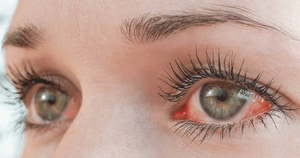Overview
Disease Overview
Dry eye syndrome (DES), also known as dry eye disease (DED), is a disorder which disrupts the physiological functioning of the preocular tear film, causing various forms of ocular discomfort and impaired vision. The term DES, commonly used by both patients and medical professionals, emphasizes the syndromic natures of the symptoms associated with the disorder. By contrast, the increasingly widespread term DED is intended to be broader and to emphasize the complex and often multifactorial etiology of the disorder. Other names occasionally used for aspects of DES include keratoconjunctivitis sicca, keratitis sicca, sicca syndrome, xerophthalmia, dysfunctional tear syndrome (DTS), and ocular surface disease; patients may refer to it simply as “dry eyes”.
The tear film is a component of tears whose functions include lubrication, protection, and nutrition of the cornea, as well as providing a refractive interface. It is approximately 2-5.5 µm in thickness,…
To continue reading
Log in or register to continue reading. It's free!
OR
By signing up to create an account, I accept Healio's Terms of Use and Privacy Policy.
Disease Overview
Dry eye syndrome (DES), also known as dry eye disease (DED), is a disorder which disrupts the physiological functioning of the preocular tear film, causing various forms of ocular discomfort and impaired vision. The term DES, commonly used by both patients and medical professionals, emphasizes the syndromic natures of the symptoms associated with the disorder. By contrast, the increasingly widespread term DED is intended to be broader and to emphasize the complex and often multifactorial etiology of the disorder. Other names occasionally used for aspects of DES include keratoconjunctivitis sicca, keratitis sicca, sicca syndrome, xerophthalmia, dysfunctional tear syndrome (DTS), and ocular surface disease; patients may refer to it simply as “dry eyes”.
The tear film is a component of tears whose functions include lubrication, protection, and nutrition of the cornea, as well as providing a refractive interface. It is approximately 2-5.5 µm in thickness, and is composed of three layers:
- The inner, mucous layer, composed of mucins (glycoproteins) secreted by conjunctival goblet cells
- The middle, aqueous layer, composed of water and water-soluble molecules (electrolytes, peptides, proteins, etc.) produced by lacrimal glands in the orbit and accessory lacrimal glands in the conjunctiva
- The outer, lipid (oil) layer, composed of lipid secreted by meibomian glands
The professional organization Tear Film and Ocular Surface Society (TFOS) combined the mucin and aqueous layers into a “muco-aqueous phase” in their second dry eye workshop (Dry Eye Workshop II, or DEWS II), and thus recognizes only two layers.
The tear film and associated glands and structures are shown in Figure 1-1.

Maintaining a physiologically intact tear film is of paramount importance for the proper focusing of light onto the retina, keeping the eye’s surface clear of debris, and keeping the ocular structures supplied with nutrients and oxygen. When DES disrupts the tear film, the resulting burning sensation and blurring of vision often have a marked impact on the patient’s quality of life (QoL). Although no treatment that targets the underlying causes of DES currently exists, both non-pharmacological and pharmacological options for the management of DES symptoms are available (see Treatment Options).
Definition
The TFOS formulated the following evidence-based definition of DES in DEWS II in 2015:
“Dry eye is a multifactorial disease of the ocular surface characterized by a loss of homeostasis of the tear film, and accompanied by ocular symptoms, in which tear film instability and hyperosmolarity, ocular surface inflammation and damage, and neurosensory abnormalities play etiological roles.”
The TFOS DEWS II definition is internationally accepted and widely adopted. For the sake of clarity, several terms from the definition were explained in more detail by TFOS DEWS II committee, including:
- Multifactorial disease: “a significant and complex functional disorder that cannot be characterized by a single process, sign or symptom.”
- Ocular surface: “comprises the structures of the ocular surface and adnexa, including the tear film, lacrimal and meibomian glands, cornea, conjunctiva, and eyelids.”
- Homeostasis: “a state of dynamic equilibrium in the body with respect to its various functions, and to the chemical composition of the fluids and tissues; Disruption of homeostasis is considered to be the unifying characteristic that encompasses the myriad of signs of tear film and ocular surface imbalance that might be observed in DED.”
- Symptoms: “a broad range of possible patient-reported experiences associated with DED including, but not limited to, discomfort and visual disturbance.”
References
- Craig JP, Nelson JD, Azar DT, et al. TFOS DEWS II Report Executive Summary. Ocul Surf. 2017;15(4):802-812.
- Golden MI, Meyer JJ, Zeppieri M, et al. Dry Eye Syndrome. [Updated 2024 Feb 29]. In: StatPearls [Internet]. Treasure Island (FL): StatPearls Publishing; 2024 Jan-. Available from: https://www.ncbi.nlm.nih.gov/books/NBK470411/



